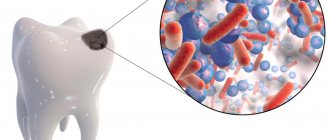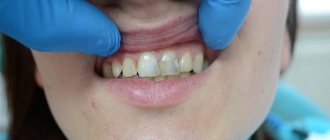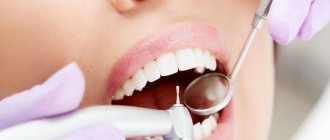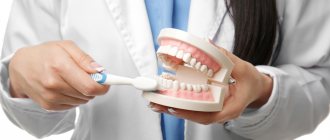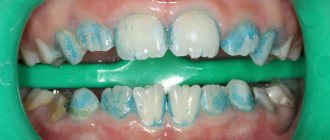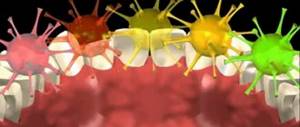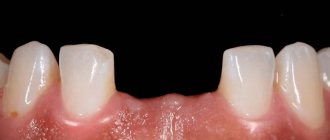Fissure caries is localized in the depressions located on the chewing surface of the teeth. Fissures have a complex structure, so they often accumulate food debris and bacteria, which cause carious lesions. We will talk about the causes, symptoms and methods of treating fissure caries in the article.
In this article
- Causes of fissure caries
- Symptoms of fissure caries
- Diagnosis of fissure caries
- Treatment of fissure caries
- Fissure caries in children
- Complications of fissure caries
- Prevention
Fissures are depressions and grooves located on the chewing surface of molars and premolars. They are grooved, cone-shaped and teardrop-shaped. In addition, they differ in depth and shape. These grooves are necessary for better chewing of food and even distribution of load across the jaw. If there were no fissures and the teeth were flat, they would often crack and split.
Food debris accumulates in the fissures, which causes the spread of bacteria. If a person has an incorrect bite or does not maintain good oral hygiene, he or she develops fissure caries.
Anatomy of fissures of the chewing group of teeth
Fissures are anatomical depressions and grooves between the cusps on the chewing surface of the crowns of the lateral teeth (premolars and molars). They provide food chopping and grinding. Depending on their structure, fissures are divided into four types:
- Cone-shaped;
- Grooved;
- Teardrop-shaped.
The deeper and narrower their shape, the greater the likelihood of developing cariogenic microflora. Food particles remain in natural cavities even after thorough brushing. This contributes to the active spread of the pathological process.
Sealant for sealing fissures
When sealing fissures in children, we offer two sealant options – transparent or milky. We recommend the second one. It is easier to control by the dentist. Due to its initial fluidity, the sealant fills the entire gap, regardless of the complexity of its shape and size.
As a result of a simple and quick procedure, the tooth surface becomes even and smooth. This is not just the prevention of caries in children, but the building of an excellent barrier, ensuring long-term protection of molars from penetration of bacteria into the enamel.
Fissure caries clinic
The carious process begins secretly and painlessly. Most patients do not attach importance to discoloration in the area of natural recesses of molars and premolars, due to which the pathology intensively develops and spreads to the deeper tissues of the tooth. The main symptoms of fissure caries:
- Changing the natural color of teeth. Due to destruction (destruction) and the activity of microorganisms, dental tissues darken. The fissures become dark brown and clearly visible;
- Hyperesthesia (increased tooth sensitivity). The tooth reacts to temperature and taste stimuli, the patient complains of pain, which goes away when the triggers are eliminated;
- Independent pain syndrome that does not stop after eliminating irritating factors. The pathological process spreads to the dental pulp, which consists of nerve fibers and blood vessels; patients note the nocturnal nature of the attacks. If the pain continues to intensify, caries develops into acute pulpitis.
Causes of the pathological process
Why does fissure dental caries appear? The very first and main reason is that bacteria settle in the natural recesses of the chewing surfaces of molars and premolars, producing toxins and caustic acids that destroy the structure of hard tissues (enamel, and then dentin). This phenomenon may be due to the following negative factors:
- insufficient and untimely hygienic care of the oral cavity, violation of cleaning technique, leading to the accumulation of bacterial soft and mineralized plaque,
- individual anatomical features: we are talking about the structure of the fissures. Everyone is different. So, if a person has deep natural grooves, then the risk of developing a carious process in them increases,
- lack of nutrients: a poor diet, frequent exhausting diets lead to fragility of dental tissues that lack calcium, magnesium, and phosphorus. Such teeth are more susceptible to bacterial attack and destruction, especially in the fissure area,
- an abundance of sweets in the diet: chocolate, candies, pastries, carbonated drinks and other foods rich in simple carbohydrates are a favorable breeding ground for microbes,
- properties of saliva: strong viscosity does not allow high-quality rinsing of food debris from teeth, and insufficient saturation with enzymes reduces enamel protection,
- rare examinations at the dentist: preventive visits to the doctor are designed to detect the problem in time and eliminate it as early as possible. After all, the disease is very difficult to detect on your own, and the dentist has all the necessary skills and tools to
- hereditary factors: poor enamel composition can not only be acquired, but also be “inherited” from close relatives. Here you can add congenital characteristics, for example, if the expectant mother suffered a serious illness during pregnancy.
Methods for studying fissure caries
Correct and timely diagnosis of caries is the key to successful treatment of the patient. It includes:
- Visual examination of the oral cavity. Allows you to identify the presence of a carious process in shallow fissures;
- Probing. Using a metal instrument, the dentist examines the density of tooth tissue. The affected tissues have a loose consistency, they retain the probe, it seems to “fall through”;
- Percussion. Using the blunt end of the instrument, the dentist checks for the presence of pain and the involvement of periodontal tissue in the process.
Additional methods for diagnosing fissure caries
- X-ray examination makes it possible to identify foci of destruction of enamel and dentin in the images, as well as to detect the spread of the process even at the initial stages;
- Using the transillumination method, the dentist can see the affected tissue without preparing the tooth. In bright light, the carious process has a brown color;
- Fissurotomy is an option for diagnosing pathology. A diamond bur is used to grind the affected enamel down to the border of healthy tissue. This method is minimally invasive and allows you to assess the extent of caries spread.
Strengthening hard tissues
So, if you have fissure caries in the initial stages, then treatment may be as follows:
- remineralizing therapy,
- fluoridation.
The essence of the methods is that with the help of applications with fluorine, calcium and other minerals, enamel is strengthened in problem areas. The procedure can be performed both in the dental office using specialized means, and at home using pastes and gels (for example, Tooth Moose, President PROFI REM Minerals Gel [3]). In any case, the drug must be prescribed by a doctor.
“My daughter had a plaque on her lower chewing teeth that couldn’t be removed. We decided to visit the dentist - the clinic didn’t tell us anything sensible. I had to look for a doctor through friends. And I was very unpleasantly surprised that it was necessary to put fillings, because... It turned out to be not a simple plaque, but caries. But it’s good that I didn’t have to drill (and the baby wouldn’t have been born). Liquid fillings were placed on 2 teeth. We need to go do 2 more.”
Olesya I., review from woman.ru
How to treat fissure caries
The basic principle in the treatment of fissure caries is the complete removal of necrotic tissue. The following stages of treatment can be distinguished:
- Opening a carious cavity with a spherical bur, removing affected enamel and dentin, creating an area for a future filling;
- Total etching with phosphoric acid to destroy pathogenic microflora;
- Drying with chlorhexidine or alcohol solution;
- Adhesive protocol, application of bonds to improve the adhesion of the composite to dentin tissues;
- Crown restoration using light-curing composite materials. The materials are illuminated with ultraviolet lamps;
- Checking occlusal contacts (correct closure of teeth), grinding and polishing the filling with special cutters and rubber attachments.
Treatment method without preparation
If caries has not yet spread to the dentin and is limited to the enamel, the dentist can offer the patient a treatment option without preparation:
- Icon technique: after etching the tooth tissue, a special infiltrate is applied to the crown. It is sealed with a transparent composite and illuminated with a lamp;
- Laser therapy: the affected areas are destroyed under the influence of radiation. Despite the fact that the equipment for this type of diagnostics is expensive, private clinics widely use it in their practice; You can learn more about laser caries treatment.
- Ozonation: acting on cariogenic microorganisms, ozone kills them and creates a protective barrier on the tooth surface.
- Using the drug Innodent Repair. Restoration of enamel and treatment of caries in the early stages of the disease.
Make an appointment with a therapist by phone+7(985)532-21-01
Treatment methods used in dentistry
Let's talk about whether it is necessary to treat a disease that affects fissures. Modern doctors will answer this question in the affirmative.
Expert opinion
Tatyana Vitalievna Varlamova
Specializations: Dentist-therapist
Experience: 2015
“The sooner treatment is started, the better for the patient, since the initial stage of the disease can be completely reversible. But if the destructive process has affected deeper layers, and it often happens that after examination and diagnosis, a large area of tissue necrosis is discovered under a small dark spot, then it is no longer possible to do without the use of a drill.”
Next, we will analyze in detail the main treatment methods in different clinical situations.
Fissure caries in children
Caries is a common pathology among children. The tissues of baby teeth are not sufficiently mineralized, which is why there are spaces in the enamel where pathogenic microflora can easily penetrate. Poor hygiene contributes to the spread of the process to neighboring areas of the dentition. Lower permanent molars are more often exposed to cariogenic processes than other teeth.
They have a complex anatomy, are the first to erupt in the bite, and do not have a maxillary pair. Despite the fact that baby teeth fall out over time, their treatment must be approached seriously and responsibly. Parents are recommended to bring their child for a dental examination once every six months, teach him how to brush his teeth correctly, using not only toothpaste, but also mouthwash, and monitor oral hygiene.
Dental prosthetics
If pathology has severely destroyed the tooth, then installing a filling may not be advisable. After all, a large-scale restoration in this case will be short-lived, it will quickly crumble and sag under the influence of chewing loads, which can even lead to chipping and loss of the tooth itself. Here, the best alternative to a filling would be an inlay, created in the laboratory using individual impressions, tightly fitting, highly durable and wear-resistant, preserving aesthetics for the entire period of operation.
If the tooth is more damaged than 50-70%, then to strengthen it you need not a classic, but a stump inlay (or pin), partially placed in the root canals and partially located above the gum. Subsequently, on such an inlay, you can build up the tooth with composite materials, but it is better to install a strong and durable crown.
Prevention of fissure caries
Prevention of fissure caries is the key to successful treatment and avoidance of relapses. The following preventive measures are distinguished:
- Fissure sealing is the most effective method to date and almost completely eliminates the possibility of recurrence of caries. It is widely used among pediatric patients, is easy to perform and painless. After preparing the tooth for the procedure, it is treated with a flowable transparent composite or glass ionomer cement. The purpose of sealing is to prevent microbes from accessing the fissures.
- The stronger the enamel, the more prismatic elements it contains and the fewer free spaces. Remineralization therapy is indicated for patients with fragile enamel. The surface of the tooth crown is treated with fluoride varnishes, preparations with a high calcium content.
Cost of dental treatment
It all depends on the severity of the disease and the method of its treatment. For the most minor lesions, when only remotherapy or a liquid filling is enough, or you can treat it with ozone, it will cost you 2000-3000 rubles. Fissure sealing will cost about 3,500 rubles.
If the disease has affected a large number of tissues, and there is no way to cope without the help of boron, then treatment will cost 4,000-7,000 thousand rubles. If complications develop (for example, pulpitis), you will have to say goodbye to at least 8,000-9,000 rubles.
If the disease has worn away the tooth too much, and there is a need to strengthen it with an inlay or even a crown, then get ready to part with at least 10-20 thousand rubles.
Prevention of fissure caries at home
It is important to observe prevention not only at dental appointments, but also at home. Oral hygiene is a complex procedure. It includes:
- Individual cleaning with a medium-hard brush. The necessary components of toothpaste are active calcium (ROCS, Colgate, etc.) and fluoride (President Classis, Splat, etc.);
- Using dental floss to clean the interdental spaces;
- For more thorough hygiene, it is recommended to use an irrigator;
- After traditional brushing, do not forget to rinse your mouth with sodium fluoride solutions. The optimal fluorine concentration in the solution is 250 ppm.
The prognosis for fissure caries is favorable. Thanks to planned treatment, oral sanitation and good hygiene, relapse can be prevented and complications can be avoided. To improve the condition of your teeth, you need to take care of them, as well as adhere to a balanced diet and exclude carbohydrates from your diet. Remember: healthy teeth are the guarantee of a snow-white smile.
Make an appointment with a therapist by phone+7(985)532-21-01
Retrograde pulpitis: diagnosis, causes, treatment, complications
Acute traumatic pulpitis treatment in the clinic on Tverskaya, Chekhovskaya
Tetracycline teeth treatment, whitening, veneers
Tooth root caries treated or removed
Tooth granuloma, what is this disease and how to cure it
Treatment of wisdom tooth caries if it hurts
Treatment of dental cyst without removal
Photo of Almadent dental clinic
Dentistry Almadent, St. Petersburg, st. Dolgoozernaya, 37, building 1
Foyer of the Almadent clinic, St. Petersburg
Doctor Savchenko S.M. consults the child in the presence of the mother
